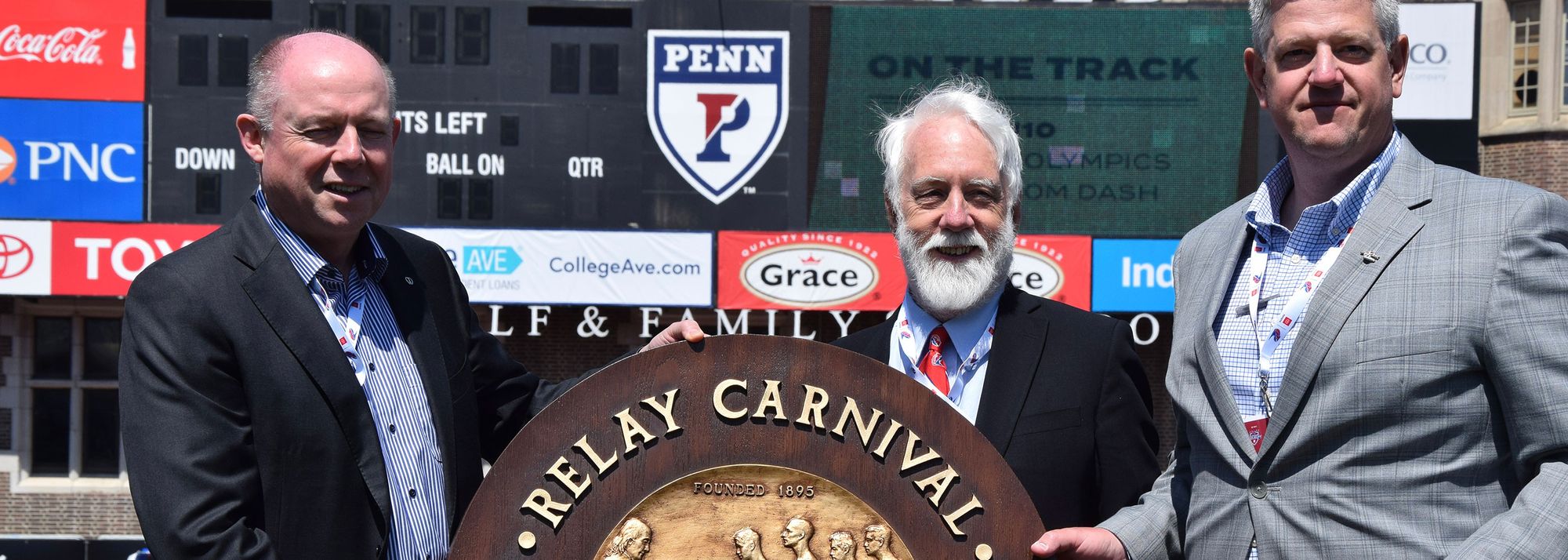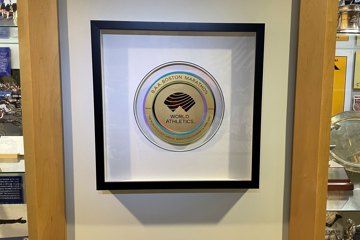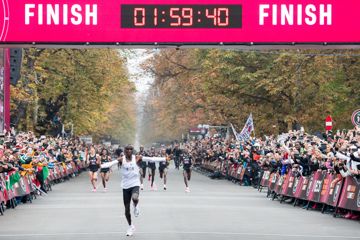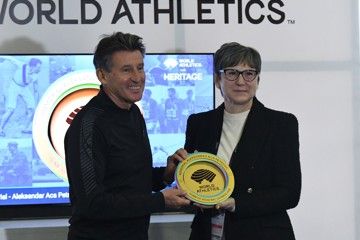Chris Turner, Dave Johnson and Scott Ward with the Penn Relays Heritage Plaque (© Rich Sands)
The University of Pennsylvania, which annually organises the Penn Relays (1895), the world’s first and largest track and field relays meeting, today (28) officially unveiled the World Athletics Heritage Plaque awarded to the competition in 2019.
The World Athletics Heritage Plaque is a location-based recognition, awarded for 'an outstanding contribution to the worldwide history and development of the sport of track and field athletics and of out-of-stadia athletics disciplines such as cross country, mountain, road, trail and ultra-running, and race walking'.
A ceremony, at which the plaque was officially presented by World Athletics Heritage to the university, took place on the infield at Franklin Field on the first morning of the 126th edition of the Penn Relays.
Taking part were Dave Johnson, the former and longest ever serving director of the Penn Relays, plus Scott Ward, executive director and chief operating officer of the Penn Relays, and World Athletics Heritage director Chris Turner.
The official plaque, which will be permanently displayed on a wall alongside the track in Franklin Field, has a replica that will be placed in the Penn Relays Photo Gallery in the building on campus where the Penn Relays offices are located.
To mark the occasion, the University of Pennsylvania presented the World Athletics Heritage Collection with a Penn Relays Plaque, which was first given out at the Carnival in 1925.

Penn Relays historical marker located on the northwest corner of Franklin Field (© World Athletics Heritage)
The history of relay racing cannot be told without Penn
The first Penn Relays was held on 20 April 1895, in conjunction with the university’s Spring Handicap Track and Field Games.
As Johnson wrote in his detailed history of The Penn Relays, “the history of relay running as sport began in 1893 at the University of Pennsylvania. While there are earlier examples of relay races having been run, nowhere else did the concept take hold and flourish. In fact, the history of relay racing cannot be told without linking it to the Penn Relay Carnival.
“When the University Track Committee, chaired by Frank B. Ellis ‘93, looked for ways of adding interest to their 1893 spring handicap meet, they struck on the idea of a relay, four men each running a quarter mile in succession.
“The idea created enough interest that a team from Princeton was invited to contest the event. Held at the end of the meet on 12 May, the Princeton team…pulled away in the homestretch to beat Penn by eight yards with a time of 3:34.0. The following year Penn exacted its revenge against the Princeton team.
“Interest in the first two years’ races was such that the committee decided to sponsor a relay meet in 1895 with hopes of reviving sagging interest in Penn track.”
The first Penn Relays was staged at Franklin Field, built on the same ground it occupies today but since changed beyond recognition. The stadium at the time had no permanent changing facilities and so a tent city was created around the field that gave the meeting the atmosphere of a carnival. The name ‘The Penn Relay Carnival’ was officially adopted in 1910.
The meeting has expanded from nine races in 1895 that attracted 5000 spectators, a huge crowd at the time, to now over 425 events, which attract as many as 110,000 fans.
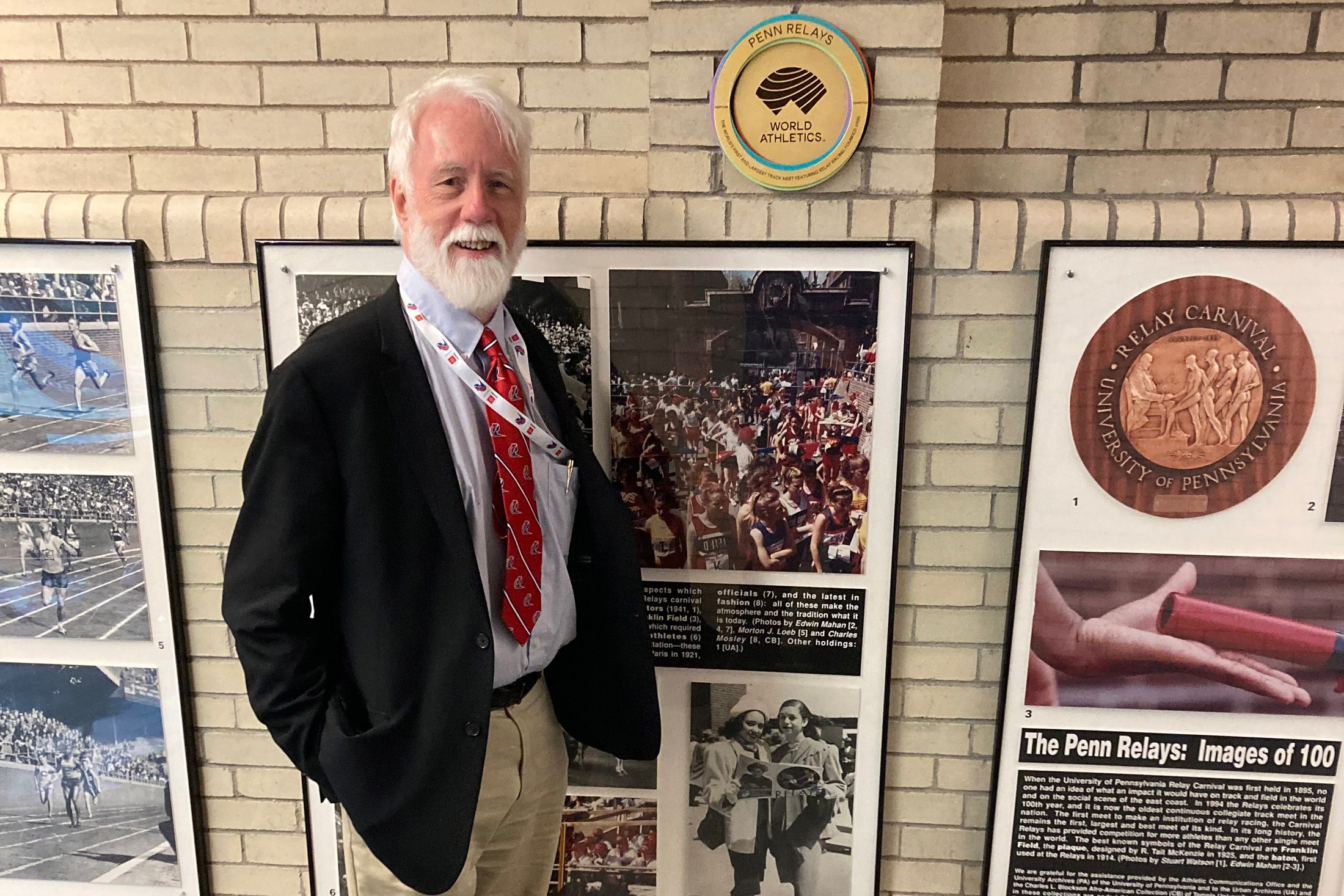
Former Penn Relays Meeting Director Dave Johnson and replica World Athletics Heritage Plaque at Franklin Field (© World Athletics Heritage)
No baton until 1913
Johnson recounts: “It was not until 1913 that a relay baton was first used at Penn. Before this, there had been neither batons nor passing zones. The incoming runner had been required to touch the next, who was required to hold his mark at the starting line.
“The baton and a 20-metre exchange zone, 10 metres on either side of the starting line, were introduced internationally in time for the 1912 Olympics in Stockholm, and the following year adopted by Penn.”
In 1914, the Penn Relays became an international affair when a team from Oxford University in England won the four-mile relay. Since then the meeting has become an increasingly important stop on the calendar for foreign teams.
It wasn’t until 1962, at the 68th edition, that an event for women was finally added. The 100-yard dash was won by Willye White, an Olympic silver medallist in the long jump in 1956, who would get a second silver in the 4x100m at the 1964 Olympics.

Chris Turner with Dave Johnson and the Penn Relays Heritage Plaque (© Rich Sands)
Nurmi and Bolt, the biggest international stars
Down the decades the Penn Relays has attracted many of the finest stars of track and field, including Alvin Kraenzlein, Jim Thorpe, Paavo Nurmi, Jackson Scholz, Eric Liddell, Jesse Owens, Roger Bannister, Al Oerter, Don Bragg, John Thomas, Wilma Rudolph, Ron Delany, Bob Beamon, Wyomia Tyus, Jim Ryun, Frank Shorter, Edwin Moses, Joan Benoit, Carl Lewis, Michael Johnson, Allyson Felix and Usain Bolt, to name but a very few.
Finland’s nine-time Olympic champion Nurmi attracted a 50,000 crowd to Franklin Field in 1929 when he ran a world two-mile record. Eighty-one years later, Jamaica’s eight-time Olympic champion Bolt was a similar headline spectator draw for the Carnival. He ran the 4x100m relay for Jamaica in 2010 as part of the USA vs. the World event, which was added in 2000 to expand the meeting’s international presence.
As The Daily Pennsylvania noted at the time of the 125th anniversary in 2019: “More athletes have run at the Penn Relays than at any single meet in the world. More spectators have watched the meet than any in the world except the Olympics and World Athletics Championships.”
Chris Turner for World Athletics Heritage


